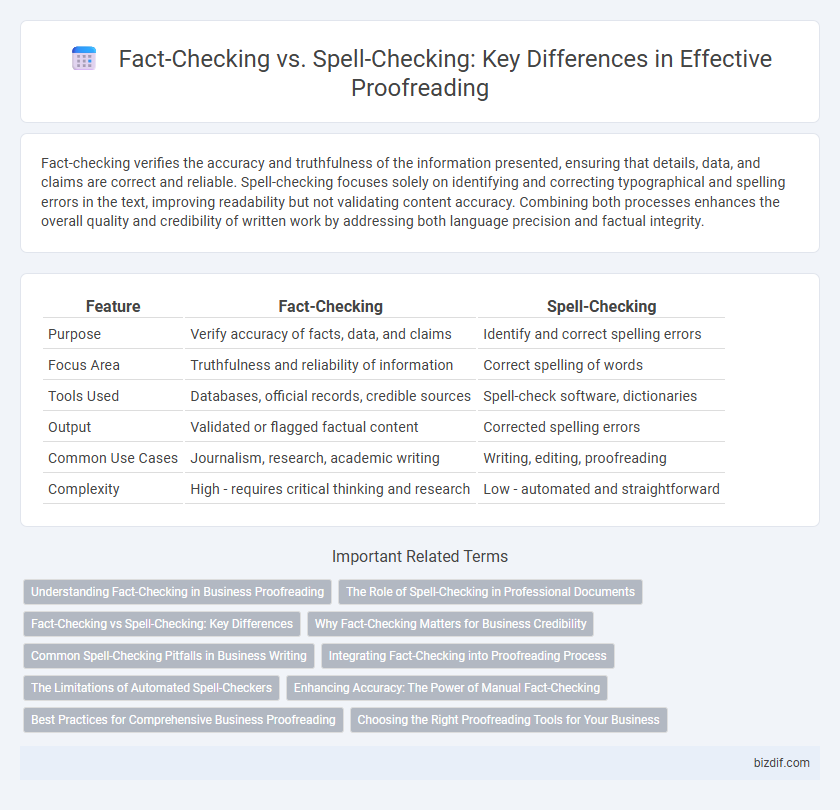Fact-checking verifies the accuracy and truthfulness of the information presented, ensuring that details, data, and claims are correct and reliable. Spell-checking focuses solely on identifying and correcting typographical and spelling errors in the text, improving readability but not validating content accuracy. Combining both processes enhances the overall quality and credibility of written work by addressing both language precision and factual integrity.
Table of Comparison
| Feature | Fact-Checking | Spell-Checking |
|---|---|---|
| Purpose | Verify accuracy of facts, data, and claims | Identify and correct spelling errors |
| Focus Area | Truthfulness and reliability of information | Correct spelling of words |
| Tools Used | Databases, official records, credible sources | Spell-check software, dictionaries |
| Output | Validated or flagged factual content | Corrected spelling errors |
| Common Use Cases | Journalism, research, academic writing | Writing, editing, proofreading |
| Complexity | High - requires critical thinking and research | Low - automated and straightforward |
Understanding Fact-Checking in Business Proofreading
Fact-checking in business proofreading involves verifying the accuracy of data, names, dates, and financial figures to ensure the integrity of corporate communications. Unlike spell-checking, which corrects typos and grammatical errors, fact-checking demands cross-referencing information with reliable sources and official documents. This process reduces the risk of misinformation, protects brand reputation, and supports informed decision-making.
The Role of Spell-Checking in Professional Documents
Spell-checking plays a crucial role in maintaining the accuracy and professionalism of documents by identifying and correcting typographical errors and misspellings. Unlike fact-checking, which verifies the truthfulness and reliability of information, spell-checking ensures that language usage adheres to standard conventions, enhancing readability and credibility. Effective spell-checking reduces distractions caused by errors, allowing the content to communicate its message clearly and authoritatively.
Fact-Checking vs Spell-Checking: Key Differences
Fact-checking involves verifying the accuracy and truthfulness of information, ensuring that facts presented are correct and reliable, whereas spell-checking focuses solely on identifying and correcting typographical errors and misspellings in text. Fact-checking requires cross-referencing with credible sources and evaluating evidence, while spell-checking relies on algorithmic detection of incorrect word forms. Understanding these key differences is essential for producing error-free, credible, and trustworthy written content.
Why Fact-Checking Matters for Business Credibility
Accurate fact-checking safeguards business credibility by ensuring all information presented is truthful and reliable, preventing the spread of misinformation that can damage reputation. Unlike spell-checking, which corrects basic language errors, fact-checking validates data, dates, and claims essential for maintaining customer trust and legal compliance. Businesses that prioritize thorough fact-checking reinforce their authority, enhance brand integrity, and reduce the risk of costly misunderstandings or legal challenges.
Common Spell-Checking Pitfalls in Business Writing
Common spell-checking pitfalls in business writing include overlooking homophones like "there" versus "their," missing context-specific jargon, and failing to catch proper nouns or specialized terminology. Spell-check tools often cannot identify words that are spelled correctly but used incorrectly, leading to confusing or unprofessional documents. Employing thorough fact-checking alongside spell-checking ensures accurate and credible communication in business contexts.
Integrating Fact-Checking into Proofreading Process
Integrating fact-checking into the proofreading process enhances content accuracy by verifying data, dates, and names alongside traditional spelling and grammar checks. Utilizing specialized fact-checking tools and databases ensures that information is reliable and prevents the spread of misinformation. Combining these methods streamlines editorial workflows and upholds the integrity of published material.
The Limitations of Automated Spell-Checkers
Automated spell-checkers often fail to detect errors involving homophones, context-specific word usage, and nuanced grammar mistakes, limiting their effectiveness in comprehensive proofreading. They cannot verify factual accuracy or the logical consistency of content, making fact-checking an essential manual process for validating information. Relying solely on spell-checkers risks overlooking critical errors that affect the credibility and clarity of written communication.
Enhancing Accuracy: The Power of Manual Fact-Checking
Manual fact-checking enhances accuracy by verifying information against reliable sources, ensuring content credibility beyond surface errors. Unlike spell-checking, which corrects spelling and grammar, fact-checking addresses the validity of facts, dates, and names critical to trustworthy communication. This meticulous process reduces misinformation and strengthens the integrity of written content.
Best Practices for Comprehensive Business Proofreading
Fact-checking and spell-checking are crucial components of comprehensive business proofreading, ensuring both accuracy and professionalism. Fact-checking verifies the correctness of data, names, dates, and statistics to maintain credibility and prevent misinformation. Spell-checking eliminates typographical errors and enhances readability, but combining both practices guarantees error-free and reliable business documents.
Choosing the Right Proofreading Tools for Your Business
Fact-checking tools verify the accuracy of information by cross-referencing data with reliable sources, ensuring content credibility, while spell-checking tools focus solely on identifying and correcting spelling errors to enhance readability. Selecting the right proofreading tools for your business depends on the nature of your content, the importance of factual accuracy, and the level of linguistic precision required. Integrating both fact-checking and spell-checking software can optimize content quality, reduce errors, and strengthen your brand's trustworthiness in competitive markets.
Fact-Checking vs Spell-Checking Infographic

 bizdif.com
bizdif.com